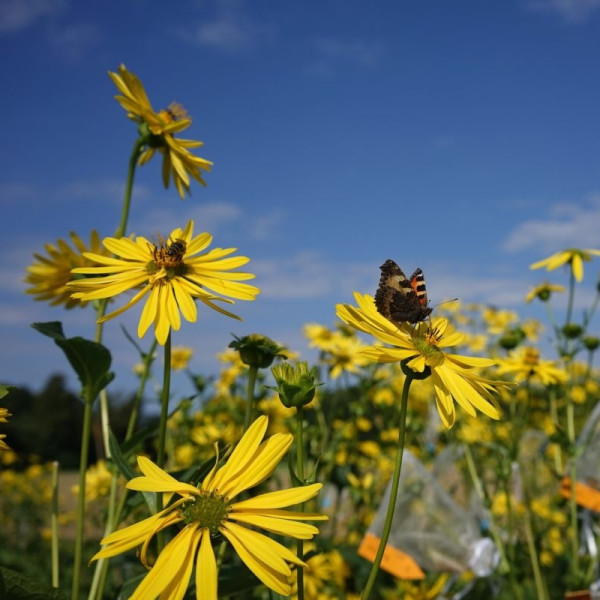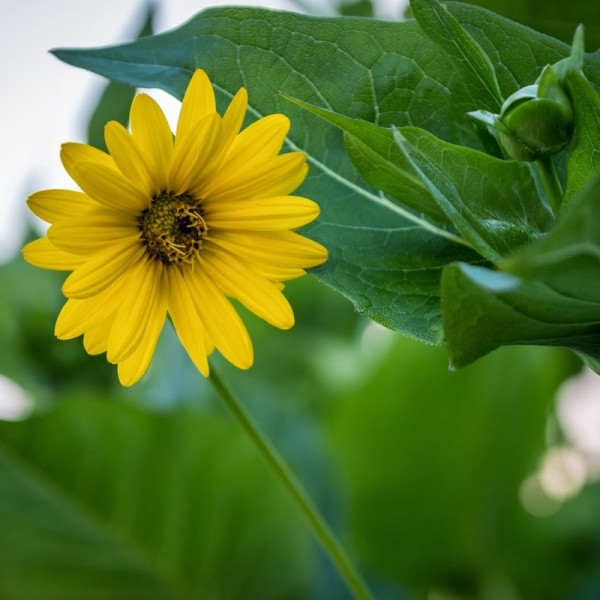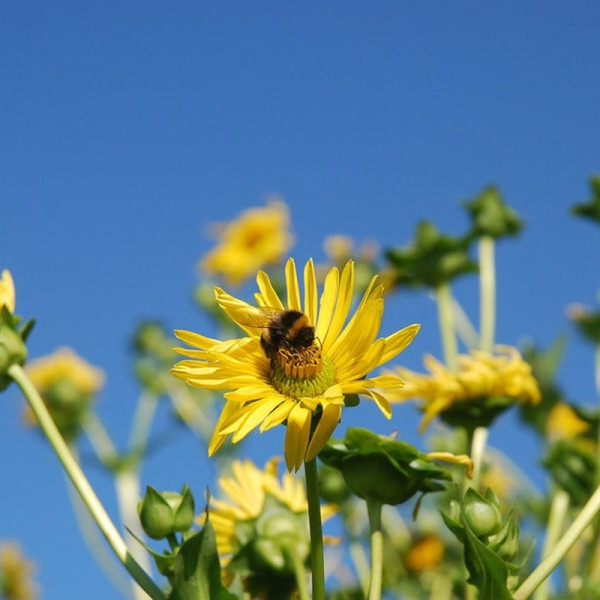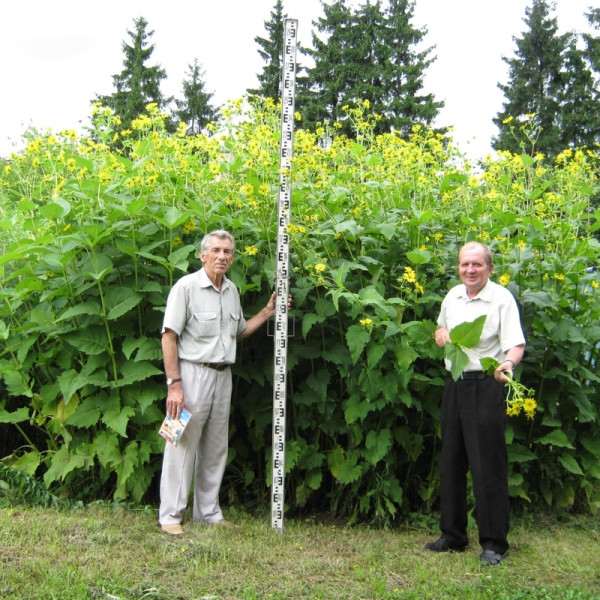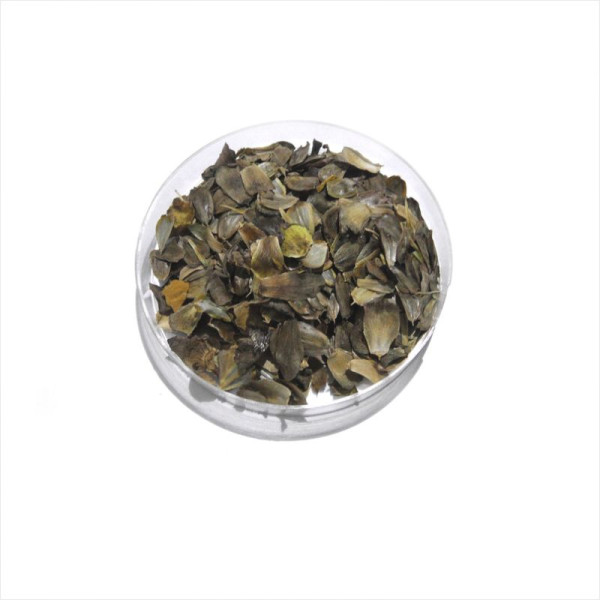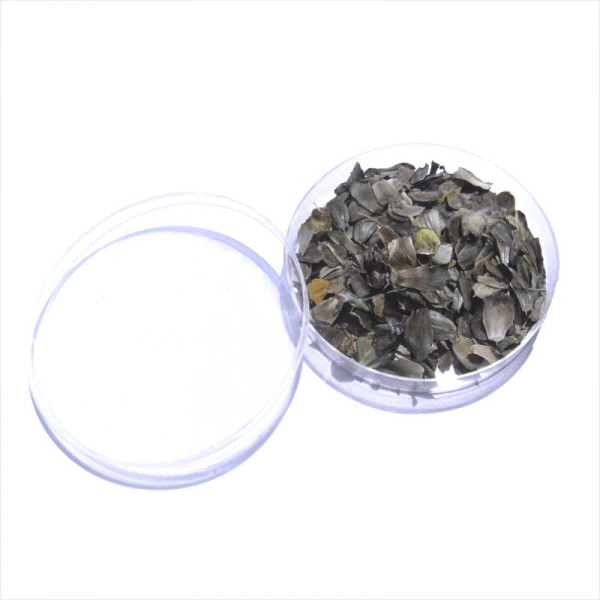Cup plant or cup-plant / Silphium perfoliatum L. - a perennial plant, undemanding to soil and climate conditions, with a long flowering period (up to 3–3.5 months) and high nectar productivity. The flower secretes nectar intensively throughout daylight hours. Cup-plant yields up to 500 kg of honey per hectare. This honey plant is known for its stable nectar production year after year.
Cup-plant is a tall species with a well-leaved, sturdy upright stem. Its flowers, 5–8 cm in diameter, are grouped into basket-like inflorescences with two types of florets: up to 33 fertile female ray florets arranged in two or three rows around the edge, and sterile tubular bisexual florets in the center. Cup-plant is rightly considered one of the best honey plants among herbaceous species.
The more bees you attract to your plot, the better your vegetable yields will be!
Cup-plant is a versatile crop with multiple agricultural uses. It is cultivated for green fodder, silage, and herbal meal. Due to its low fiber content and high vitamin levels, its green biomass is a valuable raw material for vitamin-rich herbal meal, comparable in quality to meal made from leguminous plants.
Herbal meal is a nutritious feed for all types of livestock, especially poultry. Cup-plant is also recommended for feeding rabbits and nutrias. Its green biomass is readily consumed by cows, sheep, pigs, and other animals, even unchopped. Some sources note that animals should be gradually accustomed to this new feed at the start of the feeding period.
Cup-plant blooms intensively in the second half of summer for four to five ten-day periods, attracting large numbers of bees. Its remontant flowering type makes it an excellent mid-to-late season nectar source.
Maximum benefit from cup-plant cultivation is achieved through integrated use of its crops. Primarily, it is a valuable forage and silage crop. Its various feed forms have high nutritional value. Cup-plant protein is complete and well-digested by animals. It contains significant amounts of albumins and globulins — soluble and easily absorbed protein fractions — making its green mass highly nutritious. Its protein content is close to that of traditional legumes, and it is rich in ash elements, vitamins, and micronutrients. Cup-plant protein contains 17 amino acids, including all essential ones.
Its dry matter contains about 2% calcium and up to 0.8% phosphorus. Vitamin content is also high. Leaves contain twice as much ascorbic acid as stems — 31–33 mg%. Carotene peaks in stems during flowering (30–60 mg%), and in leaves (50–100 mg%). The highest feed unit concentration occurs during fruiting (0.20–0.22 kg per 1 kg of green mass), although protein content drops to 7% at this stage.
Cup-plant begins flowering in mid-summer and continues until late September, with peak nectar flow at temperatures of 15–25°C and humidity of 70–80%. It’s a honey plant of the second half of summer!
Cup-plant is a perennial with a powerful root system. It propagates by seeds and rhizome segments. Seeds remain viable for 2–3 years. Spring germination is uneven and prolonged, while fall sowing gives excellent results. Seedlings emerge at 8–10°C and tolerate frosts down to –3…–5°C. In the first year, a rosette forms; in the second year, shoots appear. Full development as a honey plant occurs in the third year. When propagated by rhizome segments, flowering begins in the first year. In the Ryazan region, flowering lasts from mid-July until the first frosts. Seed ripening is uneven and occurs from late August through September. Cup-plant prefers soils rich in organic matter and thrives on gray forest soils, chernozems, lowlands, floodplain meadows, and areas with shallow groundwater.
Cultivation techniques
Sow cup-plant in autumn during October in dry weather before soil freezes. For spring sowing, plant in May. Seed depth: 2–3 cm, or 3–4 cm on light soils. For spring sowing, lightly compact the soil to ensure good seed-to-soil contact and faster germination. For fodder use, harvest before flowering — its protein content rivals alfalfa and clover! At the end of flowering, protein content slightly decreases but is offset by increased yield, so silage can be harvested after flowering in late August. Silage is rich in protein and other nutrients, boosting milk yield, fat content, and butter quality. For seed production, plant in open areas with good airflow to help inflorescences dry quickly after rain. Harvest seeds when 75% of flower heads turn brown.
Seeding rates: 7 kg/ha; 0.07 kg/100 m²; 0.7 g/m²
Medicinal use: Cup-plant rhizomes were traditionally used to treat rhinitis, rheumatism, and neurological conditions.
Cup-plant is an excellent perennial honey plant. In addition, it is a valuable forage crop (rich in protein, carotene, and minerals). Feeding animals with its silage increases milk yield and fat content, producing top-grade butter. As a honey plant, it fills the crucial late-summer gap in nectar flow — essential for maintaining a continuous honey harvest.
There are no reviews for this product, be the first to leave your review.

No questions about this product, be the first and ask your question.

- Best prices on the market thanks to own production
- Only original germinating seeds
